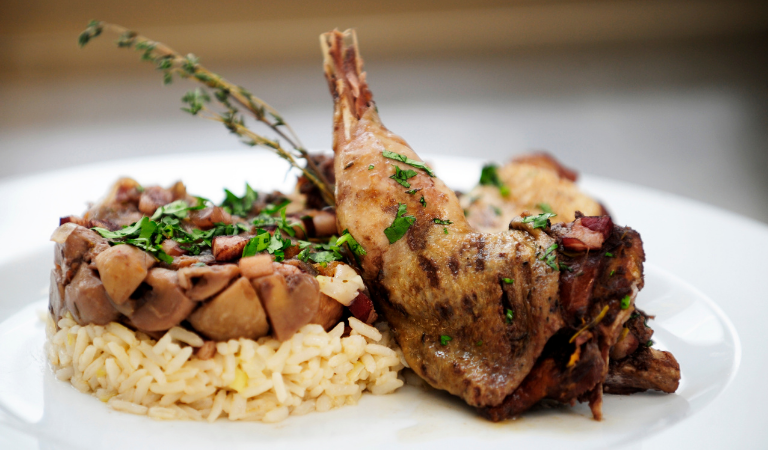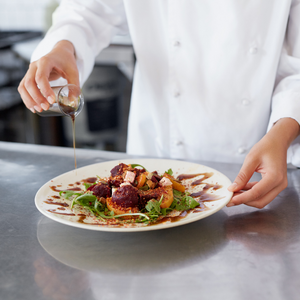Food plating is an art form: the chef is the artist, the food is the medium, and the plate is the canvas. Similar to photography or painting, food plating provides chefs with the opportunity to tell a story. They work with the colors and textures of ingredients and strategically place them on a plate to increase the perceived value of dishes. In this informative guide, we provide you with numerous food plating and presentation tips to help you elevate the aesthetics of every meal.
Why Is Food Presentation Important?
As soon as meals arrive at the table, customers begin to eat with their eyes. They are critiquing how the food tastes even before sampling it. This makes it essential to get creative and enhance the visual appeal of dishes. Below is a list of benefits for serving eye-catching meals at your restaurant:
- Supports higher price points: Properly plating dishes elevates their perceived value, ensuring customers feel like they are getting their money's worth. Patrons are willing to spend extra money on meals that satisfy their eyes and taste buds.
- Elevates flavors: Eating is a sensuous experience and satisfying your patrons' sight with artfully plated meals will make them taste better, according to research from the University of Oxford. Fulfilling all of your customers' senses increases their overall dining experience.
- Draws more exposure: In the day and age of social media, people are constantly sharing photos of aesthetically pleasing dishes. Properly plating meals will motivate your customers to post their orders and influence others to dine at your establishment.
-
Represents your brand: Customers make their first
impression of your brand based on how you plate meals. Consistently
providing patrons with one-of-a-kind food presentations allows your
brand to earn their trust.

8 Tips To Plate Like A Pro
Beautifully plated meals give your dishes a mouthwatering look and will create a buzz about your top-notch service. Here are some of the plating techniques used by professionals in the industry to create dishes with high-end designs.
1. Sketch Out Your Plating Design
Sketching your plating ideas gives you a preview of what your dish will look like before putting it on a plate. Don't worry, your drawings don't need to be exceedingly detailed. A simple outline of every component on your dish is all you need to keep revising until it's time to plate. Think about it, you'll be able to go through multiple drafts without wasting ingredients or stacking up dirty dishes. If you're having a hard time coming up with ideas, look into different types of plating styles for inspiration.
Plating Styles
- Classic approach: Food items include an entree, starch, and vegetables that are arranged like a clock.
- Contemporary approach: Consists of creative but practical placement of ingredients with sparse but eye-catching use of height.
- Freeform approach: The dish must have an abstract look. There are little to no rules involved.
- Linear approach: Food items are lined in the center of the plate, and makes use of negative space.
- Landscape approach: Inspired by landscape gardens and nature in general. Food items appear to be arranged in a simple way but contain various small details that complement the dish's overall look.
2. Pick The Perfect Plate
Generally thought of as the vessel, canvas, and frame of a dish, plates make a subtle contribution to the fluidity of your ingredients. The wrong plate can overshadow or conceal important characteristics of a meal. This is why the most essential question to ask yourself when picking out a plate is: "Which plate is going to showcase my food the best?"
Attributes Of The Perfect Plate
When searching for a plate, take a look at the following attributes to help you find what works best for your dish.
Size
A plate that is too big can make your portions seem small and can bump into other dishware on the table. While a plate that is too small can make meals look overcrowded or make it difficult for customers to move around ingredients and cause food to fall over the edge of the plate. The size of your plate should make portions seem fulfilling and give customers a comfortable eating experience.
Color
When it comes to color, you can't go wrong with white. Any dish stands out on white, making it the perfect blank canvas. If you want to highlight contrasts, dark plates would be your go-to choice. Feel like using bold or multicolored plates? Keep in mind that bold and multicolored plates can distract attention from your meal. These are okay to use if they contribute to your dish's overall design.
Shape
Think about the different textures that appear on your dish when
deciding on the shape of your plate. While a circular plate is a classic
way to present your dishes, a different plate shape can increase
fluidity and allow textures to better intermingle.
3. Place Food In An Efficient & Visually Appealing Way
The most important thing to keep in mind when placing food is to make sure your meal looks great while making it easy for the customer to eat. Here are a few ways to achieve this goal.
Easy Ways To Place Food
- Plate like a clock: Your main component should be placed at your 6 o'clock, or the section of the plate that is closest to the customer. Starches can be anywhere between 9 and 12 o'clock and vegetables should be between 12 and 3 o'clock.
- Use odd numbers: Placing food items like garnishes in odd numbers is an easy way to give your dishes an eye-catching look.
- Create an asymmetrical composition: By placing your food asymmetrically, you will be creating more negative space which in turn creates more movement and sparks visual interest.
4. Balance Color, Texture, Height, & Taste
 By creating a balance between color, texture, height, and
taste you will be giving your customers the ultimate visual and eating
experience. Hitting the balance also gives your dishes a professional
look and taste.
By creating a balance between color, texture, height, and
taste you will be giving your customers the ultimate visual and eating
experience. Hitting the balance also gives your dishes a professional
look and taste.
Create Color Balance By...
- Picking colors that match each other
- Picking colors that complement your table setting
- Changing the color of food with different cooking methods
Create Texture Balance By...
- Using foods with contrasting textures
Create Height Balance By...
- Stacking food near the middle of the plate
- Using moist ingredients as a base
Create Taste Balance By..
- Mixing crunchy and soft tastes
5. Only Use Edible Garnishes
Every garnish on your plate should be edible and thoughtfully placed. An inedible garnish on a plate will stand independently from the rest of your dish. For example, some animal fruit carvings have plastic eyes glued on their faces that impair the overall look and can be dangerous if swallowed. The best garnishes are the ones that are edible and add color or texture to your meal.
6. Have A Collection Of Plating Tools
The right plating tools will help you arrange and decorate your dishes with ease and give you a wider range of decorating techniques. While there is no required set of plating tools, everyone works differently, we put together a list of basic tools to help you get started.
Plating Tools
- Spoons: For placing large objects, sauces, purees, or creating a stylized spread on a plate.
- Small offset spatulas: For placement of smaller objects and for spreading purees across the plate. They make a wider and more dramatic spread than a spoon.
- Squeeze bottles: For thicker sauces and purees to create a more controlled fine line, dots, and other shapes.
- Ring molds: For punching out shapes, creating height on a plate, and stacking food.
- Tweezers: For fine-tuning and delicate placement, or to keep food from sticking to your fingers.
7. Create Flavor-Filled Bites
Be careful not to put too much space between your food items or else your customer will be missing out on flavor combinations. Make it easy for customers to taste multiple layers of flavors by placing food items in close proximity. Most of the components should be arranged in such a way that customers can experience a pack of well-balanced flavors in one bite.
8. Clean As You Go
Plating can be time-consuming and slow you down during your busy shifts. The best way to speed things up is by keeping your station clean at all times. Do not wait until after service hours to reorganize your mise en place and tidy things up after every order. This way, you won't find yourself looking for a misplaced ingredient and keep everything within reach.
Taste Always Comes First
Yes, plating is about the look of your dishes but the real art of plating is being able to build a plate that looks just as good as it tastes. From microgreens to entrees packed with protein, every component on your dish must work towards this goal. Both of these factors contribute to your customer's overall experience, but it's the perfect combination of both looks and tastes that distinguish a good dish from a great dish.









